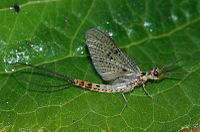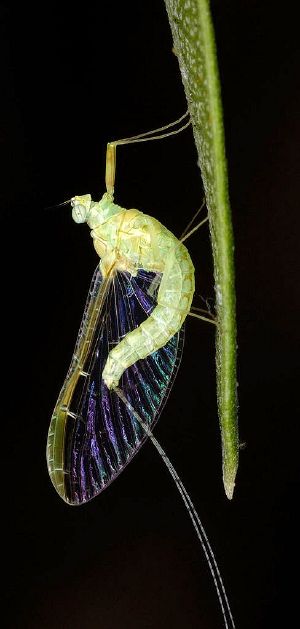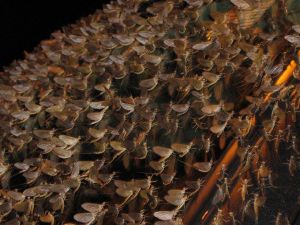Mayfly
| Mayfly | ||||||||
|---|---|---|---|---|---|---|---|---|
 | ||||||||
| Scientific classification | ||||||||
| ||||||||
|
Suborder Schistonota |
Mayflies are insects which belong to the Order Ephemeroptera (from the Greek ephemeros = "short-lived," pteron = "wing," referring to the short life span of adults). They have been placed into an ancient group of insects termed the Paleoptera, which also contains the dragonflies and damselflies. They are aquatic insects whose immature stage (called naiad or, colloquially, nymph) usually lasts one year in fresh water. The adults are short-lived, from a few hours to a few days depending on the species. About 2,500 species are known worldwide, including about 630 species in North America. Common names for mayflies include "dayfly," "shadfly," "Canadian soldier," and "fishfly" [1].
The mayfly belongs to group 1 taxa, or pollution–sensitive animals. This means if mayflies are in or around the water, the water should be good quality, perhaps even good enough to drink without distilling or boiling.
Naiads
The naiad (sometimes the term nymph is used in the older literature, and is still more common among non-scientists, although aquatic biologists use the more universal term larva) live primarily in streams under rocks, decaying vegetation, or in the sediment. Few species live in lakes, but they are among the most prolific. For example, the emergence of one species of Hexagenia was recorded on doppler radar along the shores of Lake Erie [2].
Most species feed on algae or diatoms, but there are a few predatory species. The naiad stage may last from several months to as long as several years, with a number of moults along the way. Mayfly naiads are distinctive in that most have seven pairs of gills on the dorsum of the abdomen. In addition, most possess three long cerci or tails at the end of their bodies. (Some species, notably in the genus Epeorus, have only two tails.) In the last aquatic stage, dark wingpads are visible. Developmentally, these insects are considered hemimetabolous insects. A more casual and familiar term is incomplete metamorphosis. Mayflies are unique among the winged insects in that they moult one more time after acquiring functional wings (this is also known as the alate stage); this second-to-last winged instar is usually very short, often a matter of hours, and is known as a subimago or to fly fishermen as a dun. This stage is a favourite food of many fish, and many fishing flies are modelled to resemble them.
Adult
The lifespan of an adult mayfly can vary from just 30 minutes to one day depending on the species. The primary function of the adult is reproduction; the mouthparts are vestigial, and the digestive system is filled with air. The wings are membranous (similar to a house fly's wings but with many more veins) and are held upright like those of a butterfly. The forewings are much larger than the hind wings. In most species, the males' eyes are usually large and the front legs unusually long, for use in locating and grasping females during mid-air mating. In some species, all legs aside from the males' front legs are useless.
It often happens that all the mayflies in a population mature at once (the hatch), and for a day or two in the spring or fall, mayflies will be everywhere, dancing around each other in large groups, or resting on every available surface. This happens in mid-June on the Tisza River in Serbia and Hungary; this kind of mayfly is called the tiszavirág (in Hungarian) or "tiski cvet" in Serbian which is translated as "Tisza flower." This natural phenomenon is called Tisza blooming. In certain regions of New Guinea and Africa, mayflies are eaten when they emerge en masse on a certain day.
Because of its short lifespan, the mayfly is also called one–day fly in some languages—French éphémère, German Eintagsfliege, Dutch eendagsvlieg, Slovenian enodnevnica.
Ecology
Both immature and adult mayflies are an important part of the food web, particularly for carnivorous fish such as trout in cold water streams or bass and catfish in warm water streams. They do not feed (mouthparts are vestigial), and some species emerge, reproduce, and die in a single day. Males generally fly in swarms that undulate in the air 5-15 meters above the ground.
Conservation
The status of most species of mayflies is unknown because many species are only known from the original collection data. Four North American species are believed to be extinct:-
- Pentagenia robusta was originally collected from the Ohio River near Cincinnati, but this species has not been seen since its original collection in the 1800s.
- Ephemera compar was reported from the "foothills of Colorado." Despite intensive surveys of the Colorado mayflies, this species has not been collected in the past 50 years.
- The large blue lake mayfly, Tasmanophlebia lecuscoerulea, is listed as vulnerable.
External links
All links retrieved October 18, 2007.
- American mayfly behavior, biology, and photographs
- Adult Mayfly Hexagenia sp. diagnostic photographs
- Tree of Life info for Ephemeroptera
- CSIRO page for Ephemeroptera
- Mayfly Central hosted by Purdue University
- The Vodafone Mayfly Manifesto, an unique advertising spot with the mayfly as main actor
- An animated GIF of a mayfly hatching so large that it was caught on radar by NOAA
- Photos: The greatest Tisza blooming on the World - Tisza - Kanjiza
- Bibliography of Ephemeroptera
Notes
- ↑ Born to swarm - Retrieved October 18, 2007.
- ↑ Return of the mayfly: an indicator of an improving habitat - Retrieved October 18, 2007.
Scientific literature
- L. Berner & M. L. Pescador (1988). The mayflies of Florida. University of Florida Press, Tallahassee.
- B. D. Burks (1953). The mayflies, or Ephemeroptera, of Illinois. Bulletin of the Illinois Natural History Museum 26: 1–216.
- G. F. Edmunds Jr., S. L. Jensen & L. Berner (1976). The mayflies of North and Central America. University of Minnesota Press, Minneapolis.
- W. P. McCafferty (1994). Distributional and classificatory supplement to the burrowing mayflies (Ephemeroptera: Ephemeroidea) of the United States. Entomological News 105: 1–13.
- W. P. McCafferty (1991). Comparison of old and new world Acanthametropus (Ephemeroptera: Acanthametretopodidae) and other psammophilous mayflies. Entomological News 102: 205–214.
- W. P. McCafferty (1996). The Ephemeroptera species of North America and index to their complete nomenclature. Transactions of the American Entomological Society 122: 1–54.
- W. P. McCafferty (2001). Trends in Research in Ephemeroptera and Plecoptera: 21–35.
- W. P. McCafferty, R. S. Durfee & B. C. Kondratieff (1997). Colorado mayflies: an annotated inventory. Southwest Naturalist 38: 252–274.
- W. P. McCafferty, T. Hubbard, T. H. Klubertanz, R. P. Randolph & M. Birmingham (2003). Mayflies (Ephemeroptera) of the Great Plains. II: Iowa. Transactions of the American Entomological Society 129: 77–105.
- R. P. Randolph & W. P. McCafferty (1998). Diversity and distribution of the mayflies (Ephemeroptera) from Illinois, Indiana, Kentucky, Michigan, Ohio, and Wisconsin. Ohio Biological Survey Bulletin NS13 (1): vii + 188pp.
- R. P. Randolph and W. P. McCafferty (2001). New species and records of the mayflies (Insecta) from Mexico. Dugesiana 8: 15–21.
- J. G. Needham, J. R. Traver & Y. C. Hsu. Comstock Publishing Co., Ithaca, New York.
Popular sources
- Christopher O'Toole (2002). Firefly Encyclopedia of Insects and Spiders. ISBN 1552976122.
Credits
New World Encyclopedia writers and editors rewrote and completed the Wikipedia article in accordance with New World Encyclopedia standards. This article abides by terms of the Creative Commons CC-by-sa 3.0 License (CC-by-sa), which may be used and disseminated with proper attribution. Credit is due under the terms of this license that can reference both the New World Encyclopedia contributors and the selfless volunteer contributors of the Wikimedia Foundation. To cite this article click here for a list of acceptable citing formats.The history of earlier contributions by wikipedians is accessible to researchers here:
The history of this article since it was imported to New World Encyclopedia:
Note: Some restrictions may apply to use of individual images which are separately licensed.



